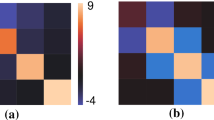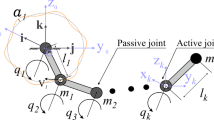Abstract
In this chapter, a review of the main methods permitting to achieve the dynamic decoupling of robot manipulators is presented. The design approaches based on the variation of mechanical parameters are disclosed via three sub-groups: decoupling of dynamic equations via mass redistribution; decoupling of dynamic equations via actuator relocation and decoupling of dynamic equations via addition of auxiliary links. The last approach is illustrated via two examples. In the first solution, the optimal design is achieved via gears used as counterweights. It is allows a considerable reduction of the total masses of links of the decoupled manipulator. In the second solution, the dynamic decoupling of robot manipulators is achieved by using an epicyclic gear train. Special attention is paid to the dynamic decoupling of robot manipulators through the use of the double integrator. The second-order linear and time-invariant dynamical system, called double integrator, is one of the most fundamental systems in control applications. It can be considered as single-degree-of-freedom translational and rotational motion. The present review considers in detail the aim of this solution, as well as the advantages of the joint application development inclosing mechanical and control solutions.
Access this chapter
Tax calculation will be finalised at checkout
Purchases are for personal use only
Similar content being viewed by others
References
Descusse J, Lafay JF, Malabre M (1988) Solution to Morgan’s problem. IEEE Trans Autom Control 33(8):732–739
Rocco P (1996) Stability of PID control for industrial robot arms. IEEE Trans Robot Autom 12(4):606–614
Santibanez V, Kelly R (1998) A class of nonlinear PID global regulators for robot manipulators. IEEE 3601–3606
Senthil Kumar J, Karthigai Amutha E (2014) Control and tracking of robotic manipulator using PID controller and hardware in Loop Simulation. IEEE 1–3
Su Y, Zheng C, Mullerz PC (2007) Global asymptotic stability of PID controller for robotic manipulators. 2007 international conference on mechatronics and automation 3244–3249
Craig JJ (2005) Introduction to robotics: mechanics and control. Pearson Prentice Hall Upper Saddle River
Ang KH, Chong G, Yun Li (2005) PID control system analysis, design, and technology. IEEE Trans Control Syst Technol 13(4):559–576
Ouyang PR, Pano V, Dam T (2015) PID position domain control for contour tracking. Int J Syst Sci 46(1):111–124
Asada H, Slotine J-JE (1986b) Robot analysis and control. Wiley
Lasalle JP Lefschetz (1961) Stability by Lyapunov’s direct method. Academic Press New York
Ouyang PR, Zhang WJ, Gupta MM (2006) An adaptive switching learning control method for trajectory tracking of robot manipulators. Mechatronics 16(1):51–61
Atashzar SF, Talebi HA, Towhidkhah F (2010) A robust feedback linearization approach for tracking control of flexible-link manipulators using an EKF disturbance estimator. IEEE 1791–1796
Levine WS (1996) The control handbook. CRC Press
Hocking LM (1991) Optimal control: an introduction to the theory with applications. Clarendon Press
Yang HS, Slotine J-JE (1994) Fast algorithms for near-minimum-time control of robot manipulators communication. Int J Robot Res 13(6):521–532
Chen Y, Desrochers AA (1989) Structure of minimum-time control law for robotic manipulators with constrained paths. Proceedings of the IEEE international conference on robotics and automation 971–976
Rao VG, Bernstein DS (2001) Naive control of the double integrator. IEEE Control Syst 21(5):86–97
Bhat SP, Bernstein DS, and others (1998) Continuous finite-time stabilization of the translational and rotational double integrators. IEEE Trans Autom Control 43(5):678–682
Slotine J-JE, Li W and others (1991) Applied nonlinear control. Prentice-Hall Englewood Cliffs, NJ
Arakelian V, Le Baron J-P, Mkrtchyan M (2016) Design of Scotch yoke mechanisms with improved driving dynamics. Proc Inst Mech Eng K: J Multi-Body Dyn 230(4):379–386
Youcef-Toumi K, Asada H (1986) The design of open-loop manipulator arms with decoupled and configuration-invariant inertia tensors. IEEE International Conference on Robotics and Automation 2018–2026
Youcef-Toumi K, Asada H (1987) The design of open-loop manipulator arms with decoupled and configuration-invariant inertia tensors. J Dyn Syst Meas Contr 109(3):268–275
Gompertz RS, Yang DC (1989) Performance evaluation of dynamically linearized and kinematically redundant planar manipulators. Robot comput-Integr Manuf 5(4):321–331
Belyanin PN, Konstantin F, Aron K, Alfred K (1981) Mechanical arm
Coelho TAH, Yong L, Alves VFA (2004) Decoupling of dynamic equations by means of adaptive balancing of 2-dof open-loop mechanisms. Mech Mach Theory 39(8):871–881
Author information
Authors and Affiliations
Corresponding author
Editor information
Editors and Affiliations
Rights and permissions
Copyright information
© 2018 Springer International Publishing AG
About this chapter
Cite this chapter
Arakelian, V., Xu, J., Le Baron, J.P. (2018). Dynamic Decoupling of Robot Manipulators: A Review with New Examples. In: Arakelian, V. (eds) Dynamic Decoupling of Robot Manipulators. Mechanisms and Machine Science, vol 56. Springer, Cham. https://doi.org/10.1007/978-3-319-74363-9_1
Download citation
DOI: https://doi.org/10.1007/978-3-319-74363-9_1
Published:
Publisher Name: Springer, Cham
Print ISBN: 978-3-319-74362-2
Online ISBN: 978-3-319-74363-9
eBook Packages: EngineeringEngineering (R0)




